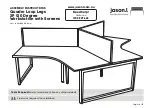
Juggler 73-404-00 Issue 1
Page 13
PSU
Power Supply Unit. The external box of electronics which alter the
supplied power voltage into the correct settings for the Juggler.
Rate
Another name for Speed. How fast a sequence is running.
Sequence
A sequence is a series of up to 99 states which are played back
sequentially. A programmed sequence can be played back manually
or automatically. Up to 12 different sequences may be programmed
on the Juggler desk.
Sequence Button
The SEQUENCE Button has several functions depending on the
operating mode (see Sequence section for further details).
Sequence Master
The SEQUENCE MASTER fader is used to control the maximum
output level from the sequence during playback.
Sequence Speed
The SEQUENCE SPEED control is used for setting the speed of
sequences on the Juggler. When the control is set to Manual, the
sequence is only advanced when the SEQUENCE Button is pressed.
Seven Segment
The Seven Segment display shows the step number in the current
sequence or the sequence number if the SHIFT button is held down.
Shift Button
The SHIFT button has a number of functions relating to Sequences
(see Sequence section for further details).
Slider
See Fader.
Snap
A fade which happens instantly.
Speed Pot
See Sequence Speed control.
Terminator
A 120
Ω
½ Watt resistor soldered between pins 2+3 of a male XLR,
which provides protection against signal ‘bounce’. This should be
placed at the end of a DMX signal chain.
Up/Down Buttons
The UP and DOWN buttons below the seven segment display are
used to select the sequence number or step number.
Wide Button
The WIDE button is used to switch the desk between two preset
operation (12 channel) or wide mode operation (24 channel).
X-fade
Another name for Crossfade. A fade from one scene to another.
XLR
The connector range used for the DMX output and Power connectors
on the back of the Juggler. There are various different XLR
connectors available, primarily 3-pin (used for Audio and some cheap
DMX devices), 4-pin (used for power and colour scrollers) and 5-pin
(used for DMX devices). Note that you should never connect a device
with a 4 pin XLR to any other device unless they were built to be used
together. Different manufacturers use different voltages on these
pins, and misuse could result in damage to one or both devices.
Zero 88
The manufacturer of the Juggler desk.
Summary of Contents for Juggler
Page 15: ......


































